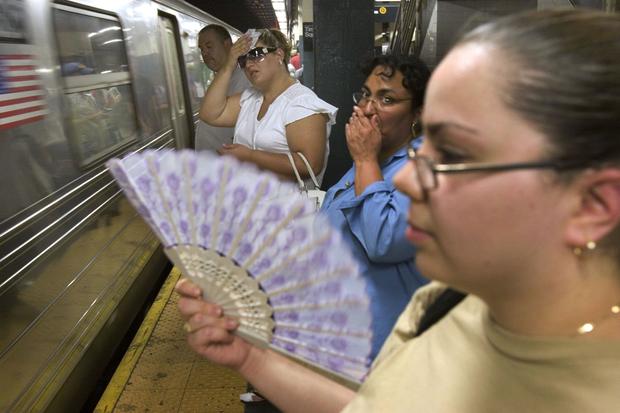New York City Could Get as Hot as Alabama in 2050
Sunday, October 12, 2014
Play
00:00 / 00:00
 Wayne Semancik of Trenton, New Jersey pours water on his head to cool himself off July 18, 2006 in New York City. (Michael Brown/Getty Images)
Wayne Semancik of Trenton, New Jersey pours water on his head to cool himself off July 18, 2006 in New York City. (Michael Brown/Getty Images) New York City will likely have weather similar to a current Southern city by the year 2050, according to the New York City Panel on Climate Change. The average summer temperature is expected to rise by 5 degrees Fahrenheit, pushing the number of days at or above 90 to around what Birmingham, Ala., experiences now. The most probable forecast by this group of scientists, selected from top research institutions in the area, calls for between 39 and 52 days a year, compared to an average of 18 now. (The miserable summer of 2013 had 16 days; this past summer only seven.)
Our NYC 2050 series, a partnership with NBC 4 New York, explores what climate change will mean to our daily lives in the coming decades. One big difference: It will be hotter.
During Chicago's 1995 heat wave, about 750 died. In France during a heat wave in 2003, the death toll came to nearly 15,000.
The elderly and those who live alone will be among the most vulnerable. Many forget to turn on air conditioning or drink enough water. The city's cooling centers are designed to help fragile citizens in the case of a heat emergency, but are not a perfect solution. By 2050, nearly 1.5 million New Yorkers will be 65 or older, according to projections by Cornell University.
Dark rooftops can grow as hot as 170 degrees Fahrenheit in the sun. Along with concrete sidewalks, brick buildings and asphalt streets, the roofs create an "urban head island effect" that adds 5 degrees to the day's temperature. making climate change even more daunting.
More New Yorkers will likely get air conditioning over the coming decades. Health officials say that's good; it will keep the death toll down. But more air conditioning will increase the risk of brown- and black-outs.
Our NYC 2050 series, a partnership with NBC 4 New York, explores what climate change will mean to our daily lives in the coming decades. One big difference: It will be hotter.
The Danger
The number of heat-related deaths is expected to increase as much as 500 percent, to potentially between 1.200 and 1,500 people a year — if temperatures rise as the climate panel predicts and no adaptation occurs.During Chicago's 1995 heat wave, about 750 died. In France during a heat wave in 2003, the death toll came to nearly 15,000.
The elderly and those who live alone will be among the most vulnerable. Many forget to turn on air conditioning or drink enough water. The city's cooling centers are designed to help fragile citizens in the case of a heat emergency, but are not a perfect solution. By 2050, nearly 1.5 million New Yorkers will be 65 or older, according to projections by Cornell University.
Dark rooftops can grow as hot as 170 degrees Fahrenheit in the sun. Along with concrete sidewalks, brick buildings and asphalt streets, the roofs create an "urban head island effect" that adds 5 degrees to the day's temperature. making climate change even more daunting.
Possible Solutions
These hard surfaces, while part of the problem, may be key in solving it. Rooftops in the city create the equivalent of 22 Central Parks. If all of them were covered with vegetation, Columbia University researcher Stuart Gaffin says, they could reduce the expected rise in temperatures from climate change by 2050. (Beyond that, however, temperatures will likely continue to outpace the mitigating effects of green roofs.) Another, perhaps simpler, option is to paint roofs white, to reflect the heat.More New Yorkers will likely get air conditioning over the coming decades. Health officials say that's good; it will keep the death toll down. But more air conditioning will increase the risk of brown- and black-outs.













0 comments:
Post a Comment